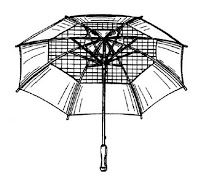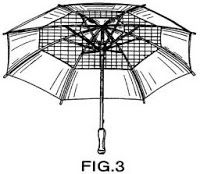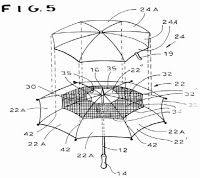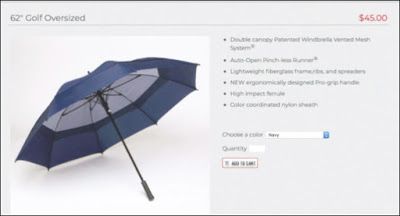In view of Applicant OEP's own utility patent, the Board had no doubt in affirming a Section 2(e)(5) functionality refusal of the product configuration shown below, for umbrellas. Although Section 2(e)(5) is an absolute bar to registration, the Board also considered OEP's claim of acquired distinctiveness under Section 2(f) but found its proofs inadequate. In re OEP Enterprises, Inc., 2019 USPQ2d 309323 (TTAB 2019) [precedential] (Opinion by Judge Christopher Larkin).

Functionality: Observing that the application drawing "depicts the mark to be registered," and that unclaimed matter must be shown in broken lines, Kohler, 125 USPQ2d at 1488 (quoting Heatcon, 116 USPQ2d at 1379) (citing Trademark Rule 2.52, 37 C.F.R. § 2.52)), the Board concluded that the assessment of functionality must take into account the entire configuration of the umbrella and not, as OEP contended, just the "mesh lower canopy of a double canopy umbrella."
OEP did not dispute that the handle, shaft, runner, and ribs of the umbrella are functional, nor that the upper canopy "blocks the rain or sunlight from the user." The question, then, was "whether the mesh canopy is also functional or, if it is not, whether its non-functionality makes the applied-for mark as a whole non-functional."
OEP owned a design patent on the umbrella design (see Fig. 3 of the design patent, immediately below), and the Board agreed that this is evidence of non-functionality. "Our law recognizes that the existence of a design patent for the very design for which trademark protection is sought 'presumptively indicates that the design is not du jure functional.'" Becton, Dickinson, 102 USPQ2d at 1377 (quoting Morton-Norwich, 213 USPQ at 17 n.3). However, the existence of a design patent is not dispositive of the functionality issue.

OEP also owned a now-expired utility patent, entitled "Umbrella and Umbrella Canopy," that depicted a dual-canopy umbrella (see Fig. 5 below). The patent specification stated that, in contrast to some prior designs that utilize die cut holes, the mesh material "provides strength to the entire first canopy portion 22, helping to keep the first canopy portion taut." Moreover, the mesh portions are "easier to sew along the panel seams," and there is less waste of material as compared to die cut vent holes. And, according to the patent, "the present invention has significantly greater airflow than prior art designs." The Board observed that the inclusion of these statements in the specification of the patent rather than in the claims "does not matter." See Becton, Dickinson, 102 USPQ2d at 1377.

Moreover several dependent claims of the patent "teach all elements of the applied-for mark, including the lower mesh canopy on which Applicant focuses on appeal." Both the claims and the specification of the patent support a finding of functionality. See Becton, Dickinson, 102 USPQ2d at 1377; In re Howard Leight Indus., LLC, 80 USPQ2d 1507, 1510-11 (TTAB 2006).
The strong and explicit evidence from the '506 Utility Patent that the applied-for mark as a whole is functional rebuts any initial presumption of non-functionality resulting from the existence of the '125 Design Patent. In fact, we view the disclosures in the '506 Utility Patent as so strong as to be sufficient, by themselves, to sustain the functionality refusal without consideration of the other Morton-Norwich categories of evidence. See Grote Indus., 126 USPQ2d at 1203.
For the sake of completeness, the Board went on to discuss the other Morton-Norwich factors.
In its advertising, Applicant OEP referred to its "[p]atented double canopy mesh system," thus reflecting OEP's view that the patented design was an improvement over previous designs (particularly with regard to preventing inversion of the umbrella). It generally claimed that its patented umbrellas are superior to other umbrellas. The Board found that these materials provided "some additional support for a finding of functionality."
As to alternative designs, OEP contended that there are many other types of "air transmissible lower canopies on the market, including various cutouts (e.g., circles, irregular shapes, etc.), no material at all, and other types of air transmissible materials." The Board noted, however, that there was no showing that these designs "work as well as Applicant's design."
Competitors are now free to produce the umbrellas taught in the '506 Utility Patent because it has expired, and competition would be inhibited if Applicant could use trademark law to prevent production of what Applicant claimed in the expired '506 Utility Patent to be a superior two-canopy umbrella design. See Qualitex, 34 USPQ2d at 1163-64.
Finally, as to cost of manufacture, the Board observed that "evidence that a design costs more, or has no impact on cost, is irrelevant if the design is found to work better." In any case, in light of the "clear statements about cost savings in the '506 Utility Patent," the Board found that the proposed mark has "at least some cost-related benefits in addition to use-related ones." Thus this factor also provided support for the finding of functionality.
The Board found that the proposed mark as a whole is functional and it therefore affirmed the refusal to register.

Acquired Distinctiveness: Even though a finding of functionality under Section 2(e)(5) precludes registration of a proposed mark, the Board went on to discuss OEP's claim of acquired distinctiveness.
The burden of providing acquired distinctiveness for a product configuration is heavier than for word marks because consumers are not predisposed to view product shapes as source indicators. See Grote Indus., 126 USPQ2d at 1210; Wal-Mart, 54 USPQ2d at 1069. Since many third parties, according to OEP, sell similarly shaped umbrellas, "a substantial showing of acquired distinctiveness" is required. Kohler, 125 USPQ2d at 1504 (quoting Udor, 89 USPQ2d at 1986).
OEP submitted direct evidence in the form of declarations from its founder and president, from four sellers of its umbrellas, and from one of its competitors, all of whom claimed to be experts "in the umbrella business." The president offered his opinion on the ultimate question of acquired distinctiveness, and all declarants opined on consumer perception of OEP's umbrella. The Board found that the declarants are experts in the umbrella business, but not experts as to how consumers perceive the design in question.
The Board gave no weight to the president's opinion on the ultimate issue, and "very little weight" regarding consumer perception. All of the declarations lacked specificity as to the basis for these opinions. Moreover the third-party declarants were not representative of all categories of end users of the product, and the use of form declarations, although not forbidden, lessened their probative value. In sum, the Board found the declarations to be non-probative.
As to OEP's circumstantial evidence of acquired distinctiveness, the Board noted that the purported mark has been in use since 1998, but long use of a mark "is not necessarily conclusive or persuasive" on the issue, Kohler, 125 USPQ2d at 1515. However, in this case OEP's long use supports its claim because there was no evidence of competitor use of a double canopy design from 1998 to 2017.
OEP's sales figures were "substantial in the umbrella industry," but large sales and advertising figures do not always compel a finding of acquired distinctiveness. OEP's advertising "did nothing to encourage readers to associate the shape of the umbrella with Applicant." The failure to do so was particularly significant because a significant portion of OEP's wholesale business comprises promotional products that are branded with the marks and logos of other companies, such as Cadillac and Lexus. In short, OEP did not provide any evidence that its advertising efforts focused on the trademark significance of the design at issue, rather than on the utilitarian benefits of the product.
Finally, OEP pointed to its policing efforts regarding the design, having successfully challenged three other entities, all of whom stopped selling their umbrellas. The Board was not impressed. It was not convinced from the scanty evidence that these entities had copied the product in order to trade on the asserted distinctiveness of the design.
Considering the evidence in its entirety, the Board concluded that OEP had failed to meet "its burden to make a substantial showing that the applied-for product configuration mark has acquired distinctiveness."
TTABlog comment: Design inventions are almost never denied patent protection due to functionality. That's because, in the design patent context, a design is unpatentable on the ground of functionality only if it is the ONLY possible design. For example, a keyway for a certain lock. On the trademark side, the test for functionality is different and broader: it considers whether the design is better than alternative designs. The fact that a design is covered by a design patent should have no bearing on whether the design is de jure functional under Section 2(e)(5). For a discussion of this point, see Prof. Sarah Burstein's 2015 article from The Trademark Reporter (here).
The content of this article is intended to provide a general guide to the subject matter. Specialist advice should be sought about your specific circumstances.

